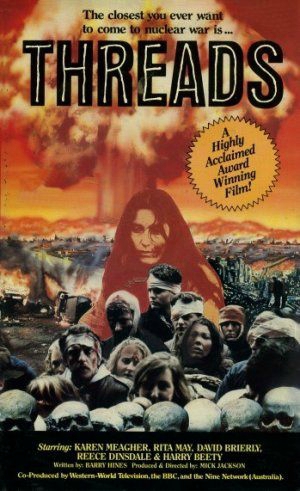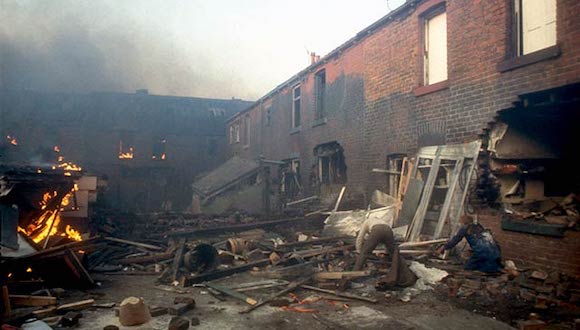 Movies don’t come much rougher than this BBC production, an unblinking depiction of the effects of a nuclear war upon a British community. This approach was previously utilized by director Peter Watkins in his classic mock-doc THE WAR GAME (also made for the BBC), but THREADS easily matches, and indeed outdoes, that film.
Movies don’t come much rougher than this BBC production, an unblinking depiction of the effects of a nuclear war upon a British community. This approach was previously utilized by director Peter Watkins in his classic mock-doc THE WAR GAME (also made for the BBC), but THREADS easily matches, and indeed outdoes, that film.
Movies don’t come much rougher…
THREADS, with its pseudo-documentary veneer, can be viewed as a sequel of sorts to Watkins’ film, which was made in 1965 and banned for two decades. In 1982 the BBC ace Mick Jackson made “A Guide to Armageddon,” a 32-minute treatise on the effects of nuclear war that aired on the BBC science program Q.E.D. When Watkins publicly criticized the show, and its clinical and indirect approach (with, for instance, the effects of extreme heat on a human body shown via a slab of meat being cooked), Jackson was stung into action, and put THREADS, a full-fledged docudrama, into production.
Scripted by novelist Barry Hines (best known for A KESTREL FOR A KNAVE, which was adapted into the acclaimed 1969 Ken Loach film KES), the film arrived amid a veritable avalanche of reality-oriented nuke movie downers, such as the famous American TV movie THE DAY AFTER, TESTAMENT, the animated WHEN THE WIND BLOWS, the French MALEVIL, the Australian ONE NIGHT STAND and the Russian LETTERS FROM A DEAD MAN. THREADS, I believe, outdoes them all.
…an unblinking depiction of the effects of a nuclear war
World War Three is clearly imminent. The residents of the British suburb Shepperton (a name recognizable to sci fi buffs as the longtime home of J.G. Ballard, who set many of his novels therein) go about their business, even though the news on their television sets is extremely upsetting: the United States demands the Soviet Union withdraw its presence from Iran or face “dire consequences.” Those consequences are put into practice when the Soviets ignore the ultimatum, which forces the United States to launch a nuclear missile, thus setting the entire Western world up for an inevitable counter strike.
Panic grips Shepperton as its residents take to frantically stocking up on food and supplies, and then it happens: the following afternoon several nuclear missiles hit the United Kingdom (because at that time the US authorities are most likely to be asleep). Deadly firestorms result, in which many people are incinerated, with the rest left to fend for themselves in a land suffused by deadly radiation.
Ruth, a young pregnant woman, finds herself adrift in this nightmarish world. She’s a fragile sort, yet somehow manages to survive mass riots, chronic food and medical shortages, a Gestapo-style purge by increasingly desperate authorities, and an inevitable turn to nomadic, stone-age living. Thirteen years after the attack Ruth finally passes on, leaving behind a teenaged daughter who becomes pregnant herself.
Jackson went on to become a Hollywood big shot with LA STORY, THE BODYGUARD and VOLCANO. In those films Jackson developed a glitzy, self-conscious style that’s virtually the antithesis of the stark and unshowy THREADS, which works precisely because it’s so low-key in its approach. The camerawork is quite concentrated, without a lot of extraneous movement, complementing a stripped-down narrative that features numerous characters and spans an entire decade, yet still succeeds in making all the points it needs to make in admirably succinct fashion. There’s also the simple fact that (outside of some background rock and roll in the early scenes) there’s no music in the entire film, which helps enhance the sense of realism.
The camerawork is quite concentrated, without a lot of extraneous movement, complementing a stripped-down narrative…

Then there are the “special” effects. Jackson’s budget was extremely limited, which is apparent in his extensive use of stock footage (such as a scratched-up documentary depiction of a nuclear bomb detonating, intercut with wide shots of people running) and still photos to make his points. Yet the film is scripted, acted and directed with such conviction the viewer is willing to overlook its budgetary shortcomings (unlike, say, PLAN 9 FROM OUTER SPACE, in which the cheapness overshadows everything else).
Furthermore, even if Jackson doesn’t succeed in transcending his budget, he pulls off some stunning sequences. A glimpse into a post-nuke hospital filled with wounded people screaming in pain (because there aren’t enough doctors on hand to help everyone) is especially powerful, as is the relentless conclusion, and a stunner of a final shot that unites the personal and collective effects of nuclear war.
…easily the most ambitious film of its kind…
The net result is a profoundly uncomfortable and depressing film, but also a necessary one. THREADS may be a relic of the cold war-infected eighties, but its lessons are equally relevant in today’s unsettled world—indeed probably even more so.
Vital Statistics
THREADS
BBC Productions
Director: Mick Jackson
Producer: Mick Jackson
Screenplay: Barry Hines
Cinematography: Andrew Dunn, Paul Morris
Editing: Donna Bickerstaff, Jim Latham
Cast: Karen Meagher, Rita May, David Brierly, Reece Dinsdale, Nicholas Lane, Jane Hazlegrove, Henry Moxon, June Broughton, Sylvia Stoker, Harry Beety, Ruth Holden, Ashley Barker, Michael O’Hagan
